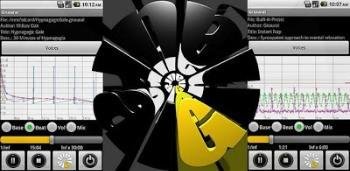Portable Gnaural Binaural-Beat Generator 1.0

Gnaural is an opensource programmable auditory binaural-beat generator, implementing the principle described in the October 1973 Scientific American article “Auditory Beats in the Brain” by Gerald Oster. The theme of the article is that the processing of binaural beats involves different neural pathways than conventional hearing. Research inspired by the article went on to show that binaural beats can induce a “frequency-following response” (FFR) in brainwave activity.
In 1839, German experimenter Heinrich Wilhelm Dove discovered that illusory “beats” are perceived when pure tones of slightly different frequency are separately and simultaneously presented to each ear. Dove’s insight was to realize that since there is no acoustic mixing of the tones, the perceived beats must exist solely within the auditory system, specifically that part which processes binaural (e.g., “stereo”) sound.
While research in to binaural beats continued after that, the subject was viewed largely as no more than a scientific curiosity. Oster’s paper was landmark not so much for its laboratory findings, but in how it tied-together the isolated islands of research since Dove in a way that gave the subject a renewed relevance to modern scientific questions.
Oster viewed binaural beats as having value both for pure research and a diagnostic medical tool. In terms of research, he felt they could be used to explain features of our auditory system, including how we locate sounds spatially in our environment and selectively single-out individual sounds from background noise (see “cocktail party effect”). Medically, Oster saw potential in BBs not only to directly diagnose auditory impairments, but to identify surprising range of seemingly unrelated medical issues. For example, Oster found strong data that diminished ability to hear binaural beats was an early predictor for Parkinson’s Disease. He also found that variation in the ability to perceive binaural beats correlated subtly with where individuals were in hormonal cycles. Central to his thesis that binaural beats involved different neural pathways than conventional hearing was the fact that binaural beats evoke neural responses even when both tone frequencies are below the human hearing threshold.
Do binaural beats influence brainwave activity?
Many consider the idea of binaural beats influencing brainwave activity “controversial”, but only the claims of what the influence means are controversial. That rhythmic stimuli can induce FFR is well established across many species, comprising a subject known as “driving”, with binaural beats falling under the category “auditory driving”, but not having a monopoly on it. Even the isochronal beating of a drum can induce FFR. But binaural beats appear to have advantages over other auditory approaches by being more efficient, both as a true low-frequency sinusoidal stimulus and by engaging more neural circuits than conventional hearing. BBs are also less invasive than some of the non-auditory approaches such as photic or electromagnetic, which are effective but induce seizures in a percentage of the population. In my experience, binaural beats have been as harmless as anything else I listen to through headphones.
